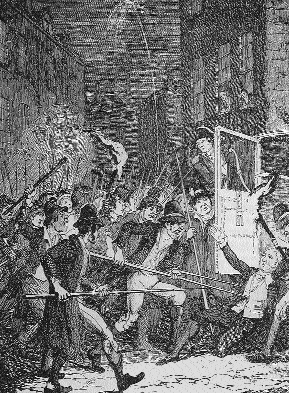Emmet’s military technology
Published in 18th–19th - Century History, Features, Issue 3 (Autumn 2003), Robert Emmet, Volume 11
Detail from The murder of Lord Kilwarden by George Cruikshank. Note the solitary rocket to the left of the picture, Emmet’s signal that countermanded the orders to rise. (National Library of Ireland)
Robert Emmet’s interest in the use of sophisticated ordnance perplexed many United Irish contemporaries, not least Wexford hero Thomas Cloney, who deemed them a waste of resources. Cloney’s point was debatable, but they were not, however, bizarre affectations of a misguided fanatic. The manufacture of hinged pikes was a simple and inexpensive means of giving urban revolutionaries an easily concealed weapon that was markedly superior to a sentry’s bayonet. This initiative had been suggested by the problems encountered on the night of 23–4 May 1798, when mobilising United Irishmen, including perhaps Robert Emmet, were rendered all too obvious by their possession of eight-foot-long pikes.
Similarly, Daniel Muley’s 1803 commission to produce 400 pistol calibre short muskets arose from the desirability of obtaining weapons suited to street fighting without alerting the watchful authorities. Military-grade black powder was available in small quantities from licensed dealers, and at least 140 pounds of cannon powder no. 1 remained in the Marshal Lane South depot when discovered in the aftermath of the rising. Stocks of this explosive compound were used to prime signal rockets which Emmet had warned trusted associates to watch for at 9.00 p.m. Rockets had been successfully test-fired at Irishtown and in the Dublin mountains above Rathfarnham in the spring of 1803, and those perfected by Emmet’s staff were entirely serviceable. It has been suggested that British expert William Congreve adapted Emmet’s designs for those he developed for the Royal Navy, but the salient fact is that the rockets were effective. In fact, the launch of one rocket in Dublin city on 23 July 1803 warned the suburban rebel units to stand down; the sight of three would have signalled that the time had come to strike local objectives. Lord Edward Fitzgerald had envisaged using rockets in this role in May 1798, and it seems highly likely that his successor as chief military strategist, Emmet, was confirmed in his view of their utility by contact with the famous American engineer Robert Fulton when living in Paris in 1800–2.
Other improvised explosive devices were crafted by Emmet’s assistants in Marshal Lane South and Patrick Street, including the much-feared ‘infernals’. Essentially, the infernals were bored and plugged logs packed with black powder and readied for detonation by fuses. Each log was rendered more lethal by hammering deal strips to their length that held small stones, metal scraps and nails in place. Emmet decided to bind two infernals to each other and mount them together on small carriages from which the wheels had been removed. Thus elevated, immobilised and sited in confined, narrow streets, the initial blast wave would have dispersed splinters, stone shards and jagged metal with terrible effect. Neither cavalry nor infantry were likely to hold formation if attacked by such a weapon, and seizing them prior to detonation would have been complicated by the necessity of approaching zones overlooked by rebel musket men and grenadiers. It seems that the infernals were deployed in a defensive role and that Emmet lacked the finances to either prepare culvert mines or unleash multiple rockets against enemy positions. Nevertheless, it seems clear that Emmet was the first revolutionary to envisage widespread use of improvised explosive devices against garrison forces in Ireland. Most military opponents privately deemed Emmet’s plans and equipment to have been of a very high standard, although this, as with so many other aspects of the rising of 1803, did not gain popular acceptance.
















